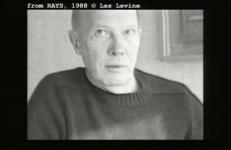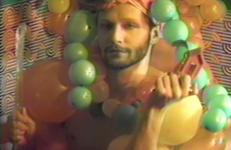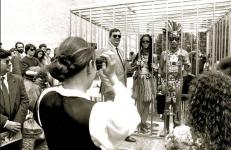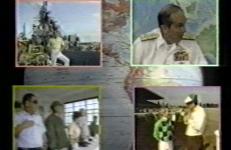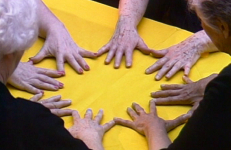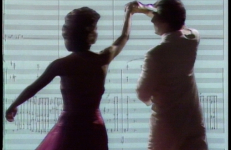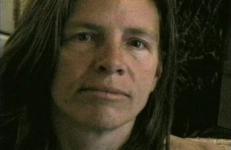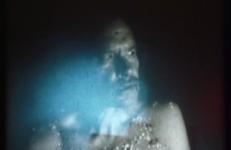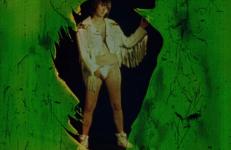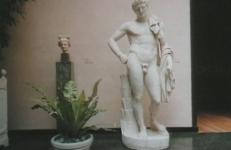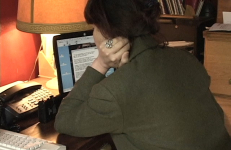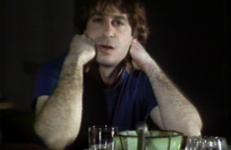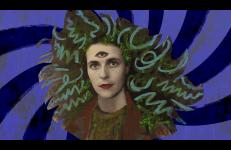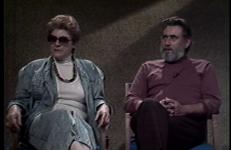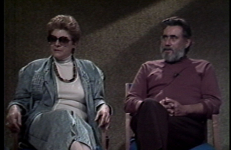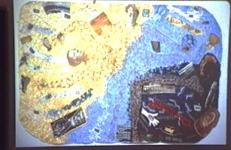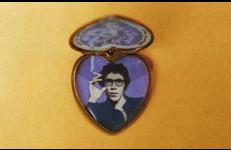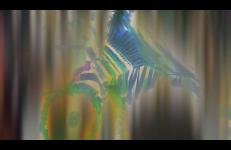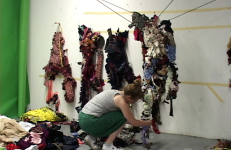A portrait of the American artist Ray Johnson (1927-95), driving force behind the New York Correspondence School of the early 1960s. Ray Johnson was mainly known for his numerous mail art projects, involving artistic strategies like networks and collaboration. Key terms in his mail art activities were ADD TO AND RETURN, or SEND TO, inviting recipients to contribute to his work. Besides mail art, Ray Johnson worked on collages, assemblages, and performance throughout his life.
Artist Portraits
Stephen Varble (1946-1984) staged gender-confounding costume performances on the streets of 1970s Manhattan, and he became infamous for his anti-commercial disruptions of galleries, banks, and boutiques. In 1978, he retreated from this public work to focus on the making of an epic, unfinished piece of video art, Journey to the Sun, until his death in the first days of 1984. Lush, ribald, and unorthodox, the video mixed non-narrative costume performances with a surrealist fable of a messianic martyr, the Warbler.
In a series of 1992 performances, Coco Fusco and performance co-creator Guillermo Gómez-Peña decked themselves out in primitive costumes and appeared before the public as “undiscovered AmerIndians” locked in a golden cage — an exercise in faux anthropology based on racist images of natives. Presented eight times in four different countries, these simple performances evoked various responses, the most startling being the huge numbers of people who didn’t find the idea of “natives” locked in a cage objectionable.
In a series of 1992 performances, Coco Fusco and performance co-creator Guillermo Gómez-Peña decked themselves out in primitive costumes and appeared before the public as “undiscovered AmerIndians” locked in a golden cage — an exercise in faux anthropology based on racist images of natives. Presented eight times in four different countries, these simple performances evoked various responses, the most startling being the huge numbers of people who didn’t find the idea of “natives” locked in a cage objectionable.
Uncomfortable journeys through the work and ideas of Christopher Cozier, a leading contemporary artist in the Caribbean. The video presents Cozier's witty and incisive drawings, installations and videos in the context of post-independence Trinidad with its oil-rich economy, complicated ethnic politics, and vibrant cultural forms.
"This is a videotape about Television. It is a fragmented, personal view. It is only one of many ways to explore television. This is a videotape about the cosmetics and packaging of television. It is about editing..."
--Antonio Muntadas
"This is a videotape about Television. It is a fragmented, personal view. It is only one of many ways to explore television. This is a videotape about the cosmetics and packaging of television. It is about editing..."
--Antonio Muntadas
“The idea was to address the cultural invisibility of older women through art and through action,” the voice-over explains as this video begins. This short works offers an introduction to the Whisper Minnesota Project, which organized The Crystal Quilt performance, an event that brought together hundreds of women over 60 on a Mother’s Day in Minneapolis. As the video explains, “The Crystal Quilt is a case study in reframing notions of older women’s beauty, power, and relevance. Through it we catch glimpses of life patterns and values lost to our generation.”
A portrait of influential Dutch musician and composer Louis Andriessen, as he talks about composing a new work. Andriessen draws inspiration from the life of Dutch painter Piet Mondrian and his love for ballroom dancing.
This video is an unabashed fan letter to poet Eileen Myles. As in Laurie, my desire was to romanticize the poet, but not through her writing so much as through her reputation as the natural born child of the New York School and the Beats. I shot the movie as I imagined Robert Frank and Alfred Leslie shooting Pull My Daisy, a film that left an impression on me chiefly of the struggle between form and formlessness, plan and improvisation, sketch and story.
"You always have to be careful. You always have to have the shower backward in order to see the water, which means you better watch out, or you might electrify, or electrocute your stars. You know what I mean, by having the light falling into the tub."
--George Kuchar
Encounters I May Or May Not Have Had With Peter Berlin deals primarily with monumentality, narcissism and the ways in which our heroes are embedded into our identities, and manifested through the body. Through a variety of gestures, the pervasiveness of this practice is highlighted alongside its ultimate, inevitable failure. The viewer moves through various stages of anxiety, idolization and actual touchdown with 1970s gay sex icon Peter Berlin himself, capturing both the apparent and the hidden.
Consisting of 13 brief spots, Experience: Perception, Interpretation, Illusion features works by artists included in a Pasadena Armory exhibition. Curator Noel Korten explains that the artists in the show have all reached mid-career and are now less concerned with expanding the boundaries of contemporary art than on reflecting back on culture through their own perspectives. Artists include Karen Carsen, John Outterbridge, Michael C.
In collaboration with art historian Dore Bowen, a video recording of her phone interview with Yoko Ono during which a discussion of John Cage and chance operations intervene. Shot in 2002, this document was released in 2007.
Southern California visual artist Jud Fine seeks to promote democracy in art—the idea that anyone can be an artist. This video presents the artist and his work in a style that reflects the multi-layered dimensions of his artwork.
Reverend Howard Finster was a preacher-turned-folk artist. He created Paradise Gardens Park & Museum, a product of all his murals, drawings, sculptures, and mosaics—and Summerville, Georgia’s largest tourist attraction. He began Paradise Gardens around 1961; in 1976 he responded to a vision to paint sacred art. As this video begins, Finster is painting with his hands in his studio. Finster then embarks on his first visit to New York City and comments upon his exhibition at Phyllis Kind Gallery. He spins rhythmic narratives that turn into miniature sermons.
Featuring Vito Acconci, Richard Serra, Willoughby Sharp, Keith Sonnier, and William Wegman
Richard Ross discusses his interest in photographing museums—their display of objects, frames, the entire context—in order to question our definitions of the museum. The video also covers his ongoing series of triptychs made using a child’s plastic camera, which Ross turns into “art historical soap operas” by playing off the interactions of the groupings.
Only available on the Fellows of Contemporary Art compilation.
In 1971, graduate student Gloria Orenstein receives a call from surrealist artist Leonora Carrington that sparks a lifelong journey into art, ecofeminism, and shamanism. A wife and mother of two writing her dissertation for New York University, Orenstein never expects to have her life transformed through female friendship.
This husband and wife team has collaborated on numerous projects in the U.S.and abroad. Their approach to making art involves finding solutions to ecological problems. Both are emeritus professors in the department of visual arts at the University of California-San Diego. Interview by Michael Crane.
Eco-artists Helen and Newton Harrison define truth as a series of interactions that anyone may join. The Harrisons choose survivalist subjects because we have so encroached upon this environment, we must give it every advantage we can. Only available on the Fellows of Contemporary Art compilation.
Taped shortly after the creation of the Air Gallery, this conversation between painter Howardena Pindell and Hermine Freed concerns the women’s independent gallery and its role in the feminist movement. Pindell also discusses the development of her work and the relation between black artists and the art world.
Matt Wolf returns to Joe Brainard's iconic poem I Remember (1970) in this videowork. His archival montage combines audio recordings of Brainard reading from the poem, as well as an interview with his lifelong friend and collaborator, the poet Ron Padgett. The result is an inventive biography of Joe Brainard, and an elliptical dialog about friendship, nostalgia, and the strange wonders of memory.
An elegy to Diane Burns on the shapes of mortality and being, and the forms the transcendent spirit takes while descending upon landscapes of life and death. A place for new mythologies to syncopate with deterritorialized movement and song, reifying old routes of reincarnation. Where resignation gives hope for another opportunity, another form, for a return to the vicissitudes of the living and all their refractions.
“I’m from Oklahoma I ain’t got no one to call my own.
If you will be my honey, I will be your sugar pie way hi ya
way ya hi ya way ya hi yo.”
This film observes six art students working in their studios in parallel. It offers a rare glimpse into the inside of art school studios.




